The United States of inequality
David F. Ruccio [University of Notre Dame]Copyright: David F. Ruccio, 2020
You may post comments on this paper at https://rwer.wordpress.com/comments-on-rwer-issue-no-92/
People on the streets are starting to say, enough. Enough of the inequality, and enough of not having a story about how this ever gets better (Paul Mason, “Capital in the 21st Century”).
We’re not all in this together
I’m almost sick of hearing the refrain, “We’re all in this together”.
I say almost, because I do think there’s a utopian moment in that phrase in the midst of the current pandemic. It speaks of solidarity, of being in common, of paying attention to and honoring healthcare workers and others who are currently laboring in “essential” activities while the rest of us are instructed to stay at home. In that sense, it betokens – or at least aspires to – a thinking about and caring for others.
Otherwise, and this is why I’m getting tired of it, the expression serves to deflect our attention from and to paper over the obscene inequalities that afflict American society. I’m referring not only to the pre-existing unequal condition of the United States – the sharp fissures and enormous chasms that were prevalent before COVID-19, which have been highlighted by its spread – but also to the ways the gap between the haves and have-nots has played an important role in actually causing the spread of the dreaded disease, as well as to the real possibility those inequalities will only get worse as a result of the pandemic and the way the response to it has been devised and implemented in the United States.
It has now become almost commonplace, at least within the liberal mainstream media, to note that the unfolding of the novel coronavirus pandemic and the ensuing economic crisis have focused a spotlight on the grotesque inequalities that preceded their onset. With every day that goes by, it has become clearer that the spread of the virus has been profoundly lopsided and uneven – from access to testing and decent, affordable healthcare through who’s been able to shelter in place to the presence of underlying “comorbidities”, all of which have made the virus both more prevalent and more lethal among working-class Americans, including black bus drivers and Hispanic meatpackers, who had already been left behind.
The pandemic has also brought with it an escalating economic crisis – and that too has reflected existing inequalities. On one hand, tens of millions of low-wage workers have been especially vulnerable to layoffs, furloughs, shortened hours, and pay cuts, with restaurant and retail workers particularly at risk, increasingly obliged to acquire sustenance for themselves and their families in the country’s understocked food pantries. On the other hand, millions of other workers – who change the linens in hospitals, aid the sick and dying in nursing homes, pack and transport commodities, pick strawberries, and deliver food – have been forced to have the freedom to continue to commute to and labor at their jobs in perilous conditions, increasing the risk of contagion to themselves, their families, and the communities in which they live.
Meanwhile, the former or current employers of those same workers have been lining up to receive loans from private banks and through the various government bailouts, with few if any restrictions (e.g., on stock buybacks and dividend payments to shareholders), billionaires like Jeff Bezos and Elon Musk have profited handsomely and have seen their wealth soar, and high-profile chief executives of corporations have announced voluntary salary cuts, which turn out to be nothing more than publicity stunts
Not only do the consequences of the pandemic appear to reflect existing inequalities. It also seems to be the case that those same inequalities are acting as multipliers on the coronavirus’s spread and deadliness. It is no coincidence that the United States, with the most unequal distribution of income and wealth among rich countries, also has the highest number of confirmed cases of and deaths from the coronavirus. One reason is that, as inequality has increased, health disparities themselves have widened – and lower-income Americans are much likelier than those at the top to have one or more chronic health conditions, thus exposing them to more risk from the coronavirus. Moreover, those same people are the ones who have been continuing to work in their “essential” in-person jobs, which require more contact both with other workers and customers. In other words, workers, who have more health problems and less health care, are at greater risk of transmission.
The pandemic under extreme inequality thus involves a devastating feedback loop, for workers and society as a whole. The people who can least afford it, given their health and working conditions, are forced into the position of being more exposed to contagion and becoming agents of transmitting the disease to others – in their workplaces and households and in the wider community.
And there’s another feedback loop, or cycle of injustice – from existing inequalities through the uneven effects of the pandemic to even more inequality in the future. As Charlie Cooper has argued,
With social distancing here to stay for the foreseeable future, it’s becoming increasingly clear that the next stage of the pandemic is going to change many lives for the worse.
Specifically, it’s going to exacerbate existing inequalities, as the privileged buffer themselves against its pernicious effects while the world’s most vulnerable struggle not to fall through the rapidly widening economic fissures.
For one thing, even after recovery from the immediate affliction, the coronavirus infection may cause lasting damage throughout the body, thereby worsening both the health and economic activity of some (still unknown) portion of an entire generation.
On top of that, the effects of the economic crisis, with tens of millions of workers furloughed or laid off while banks and corporations are bailed out and the stock market is on the rebound, may be even worse than those of the Second Great Depression. Let’s remember that, aside from a brief hiatus (in 2009), the trend of growing inequality that preceded the crash of 200708 was quickly restored during and after the so-called recovery.
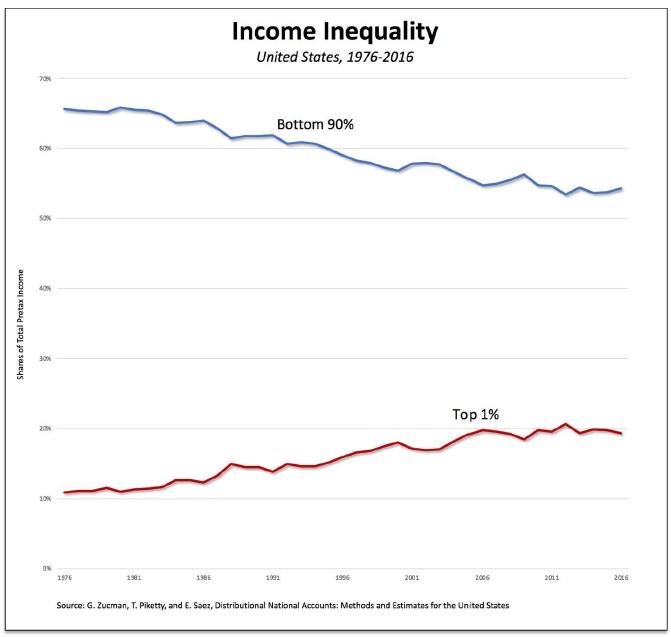
For example, in 2007, the top 1 percent of Americans captured 19.6 percent of pretax national income (the red line in Figure 1), while the bottom 90 percent had only 55 percent (the blue line). By 2016 (the last year for which data are available), the percentages were 19.3 and 54.3, respectively.
The story of wealth inequality is even more dramatic: while the share of wealth owned by the top 1 percent (the green line in Figure 2) grew from 34 percent in 2007 to 36.6 percent in 2016, the small share owned by the bottom 90 percent (the purple line) actually fell, from 30.9 percent to 28.7 percent. Meanwhile, the share of total wealth owned by the bottom 50 percent of U.S. households barely changed, rising from a miniscule 0.3 percent to a still-tiny 0.4 percent.
Since we’re only two months into the current crisis, we still don’t know what the final outcome will be. Even a quick, V-shaped economic recovery (which Trump and his economic advisers are promoting but about which I have serious doubts) would still be accompanied, according to current modeling, with millions of cases of coronavirus and more than 100 thousand deaths, spread unevenly across the U.S. population (especially now that the Trump administration and many governors are focused almost entirely on reopening businesses and forcing workers off unemployment, to compete with one another for the smaller number of existing jobs). While the effects of a longer and more severe downturn – a Third Great
Depression, perhaps – will likely be characterized, especially since there have been no major policy shifts compared to a decade ago, by the same kind of unequalizing dynamic.
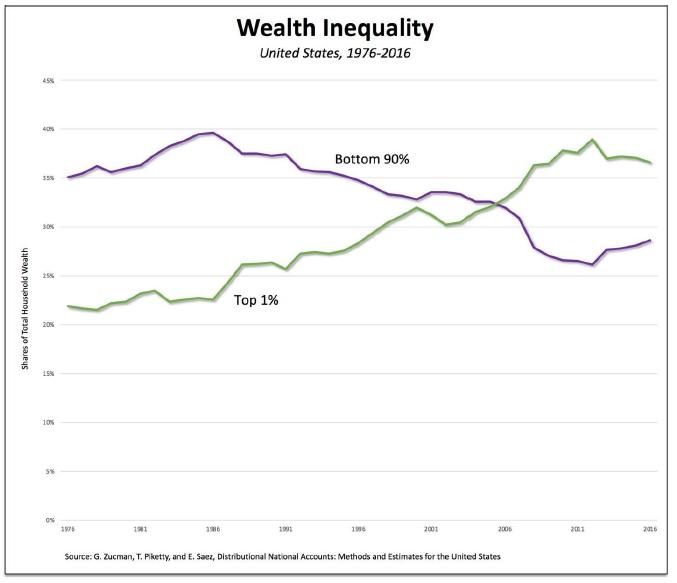
All signs, then, point to the fact that existing inequalities will give rise, on their own and through the consequences of the pandemic, to even more obscene levels of inequality in the immediate future – unless, of course, there is a profound change in the way the American economy and healthcare system are currently organized. Only by eliminating those inequalities can Americans create the real conditions, during the pandemic and after, for being in this together.
What inequality?!
The fact is, even before the novel coronavirus pandemic started to ravage the country, economic inequality in the United States was so obscene, and had convinced more and more people to do something about it, that the business press had initiated a campaign to deny its very existence.
They and the interests they represent were already losing the battle of public opinion. And they decided to do whatever they could to turn things around.
First up was The Economist, the “newspaper” of record for liberal capitalism, claiming that new research undermines the pillars of the seemingly universal belief that “inequality has risen in the rich world.” Yes, as I have documented from the very beginning on my blog (e.g., here, here, and here), there are plenty of mainstream economists who have attempted to prove that inequality isn’t really a problem – either because it doesn’t really exist or, if it does, it’s not something we can or should do much about. So, The Economist managed to find pieces of research that call into question some of the key pillars of the inequality argument –that the gap between the top 1 percent and everyone else is growing, the middle-class is shrinking, capital is gaining at the expense of labor, and wealth inequality is soaring.
There’s no need to waste readers’ time repeating the arguments I and many other real-world economists have made on all four of those points over the past decade. Readers can use the search function on this blog to see what I and others have written on these issues – or just read the recent report from the Congressional Budget Office, which I discuss below.
What’s more interesting is where The Economist wants to take the discussion – away from wealth taxes (of the sort proposed by Democratic presidential candidates Bernie Sanders and Elizabeth Warren) and toward the sorts of policies that, while they won’t lessen the degree of inequality, conform to The Economist’s fantasy of liberal capitalism. Thus, they propose more building (so that young workers can afford housing), antitrust regulation (as if capitalism didn’t have an inherent tendency toward monopoly), less regulation of high-income professions (to create more competition for those high-paying jobs), and fewer restrictions on immigration (but only for “high-skilled” workers).
That’s The Economist’s derisory attempt to minimize the existence of inequality (against most of the available evidence and widespread belief) and to devise some tiny tweaks in existing economic arrangements (and thereby avoid more serious efforts to lessen the degree of inequality).
The Wall Street Journal also decided to confront the growing campaign against economic inequality – by attempting to show that Donald Trump’s administration has done more to decrease inequality than Barack Obama’s, by promoting economic growth through deregulation and increased business investment. Now, it’s true, Obama oversaw a bailout of Wall Street and a return (after, as I explain above, a brief hiatus in 2009) to the same unequalizing trends that predated the Second Great Depression. So, that’s a very low bar to surpass.
And even though the wages of low-income workers had been rising at a faster rate before the pandemic (the supposedly “happy wages of a growing economy”), it is still the case that the wage share of national income (as seen in Figure 3) is still less than what it was in 2008 (when it was 44.9, compared to 43.2 in 2018) and far below its postwar peak in 1970 (at 51.6).
To rely on continued growth to solve the problem of inequality is simply a pipe dream, which is even less convincing than the castle in the air invented by the business press on the other side of the pond.
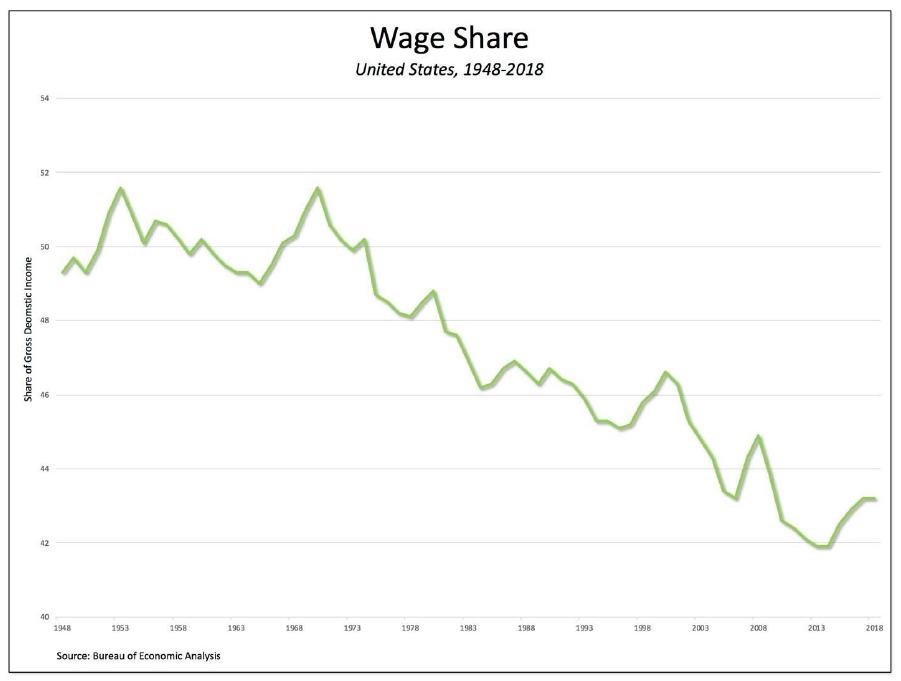
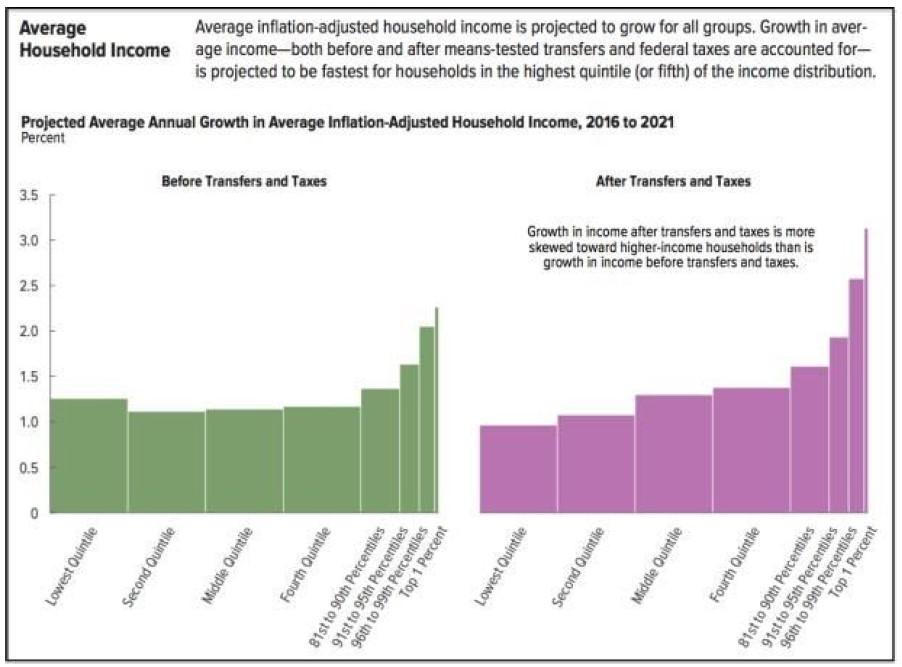
The fact is, the Congressional Budget Office [pdf] projects that income in the United States –both before and after transfers and taxes – will be more unevenly distributed in 2021 than it was in 2016. That’s because, even though average incomes for the bottom four quintiles are expected to grow, incomes for the top quintile (and especially for the top 1 percent) are expected to grow even faster.
Thus, for example, since 1979, while the average incomes of the middle three quintiles are expected to grow (after transfers and taxes) by a total of 57 percent, the incomes of those in the top 1 percent are projected to increase by a whopping 281 percent by 2021.
There’s no other way around it: inequality in the United States is obscene, and something –much more than minor regulations and continued growth – needs to be done to overcome it. As it turns out, Americans are fully aware of the problem. For example, according to Gallup, the overall opinion of capitalism held by young adults (both Millennials and Gen Zers) has deteriorated to the point that capitalism and socialism are tied in popularity.
And a recent Reuters/Ipsos poll found that nearly two-thirds of respondents agree that the very rich should pay more.1
Among the 4,441 respondents to the poll, 64 percent strongly or somewhat agreed that “the very rich should contribute an extra share of their total wealth each year to support public programs” – the essence of a wealth tax. Results were similar across the lines of gender, race and household income. While support among Democrats was stronger, at 77 percent, even a majority of Republicans, 53 percent, also agreed with the idea.
Moreover, when asked in the poll if “the very rich should be allowed to keep the money they have, even if that means increasing inequality,” 54 percent of respondents disagreed.
That’s the reason The Economist and The Wall Street Journal decided to launch their campaign about inequality – to attempt to undermine the widespread belief that inequality is growing and, even more, to challenge any and all efforts to actually do something to create a more just, less unequal economy and society.
Such a campaign may satisfy their readers, at least in the short run, but the problem itself will remain. This election year, especially in the midst of the latest wave of the COVID-19 pandemic, I expect the growing gap between the tiny group at the top and everyone else to overshadow their shabby efforts.
1 Ironically, another recent attempt to undermine the Sanders-Warren proposals of new, higher wealth taxes actually serves to reinforce how extreme wealth inequality is in the United States. While admitting that “only a small segment of the population would be subject to the top rate,” the American Action Forum’s Douglas Holtz-Eakin and Gordon Gray [pdf] can only conclude that the taxes would have “broad impacts” only because the wealth holdings of that group “constitute a significant share of the investable wealth in the economy.”
Wages, relative immiseration and surplus
Wages and productivity
Mainstream economists continue to insist that workers benefit from economic growth, because wages rise with productivity.
Here’s the argument as explained by Donald J. Boudreaux and Liya Palagashvili:
Firms cannot afford a misalignment of their workers’ pay and productivity increases – the employees will move to other firms eager to hire these now more productive workers. Higher economy-wide productivity, after all, means that workers add more to the bottom lines of employers throughout the economy. To secure the services of these more-productive workers, firms bid up worker pay. This competition for labor services is what links pay to productivity.
Except, of course, the link between wages and productivity has been severed for decades now, going back to the late-1970s. Since then, as the research staff of the Economic Policy Institute have shown, productivity has increased by 70.3 percent but average worker’s wages have risen by only 11.1 percent.
5
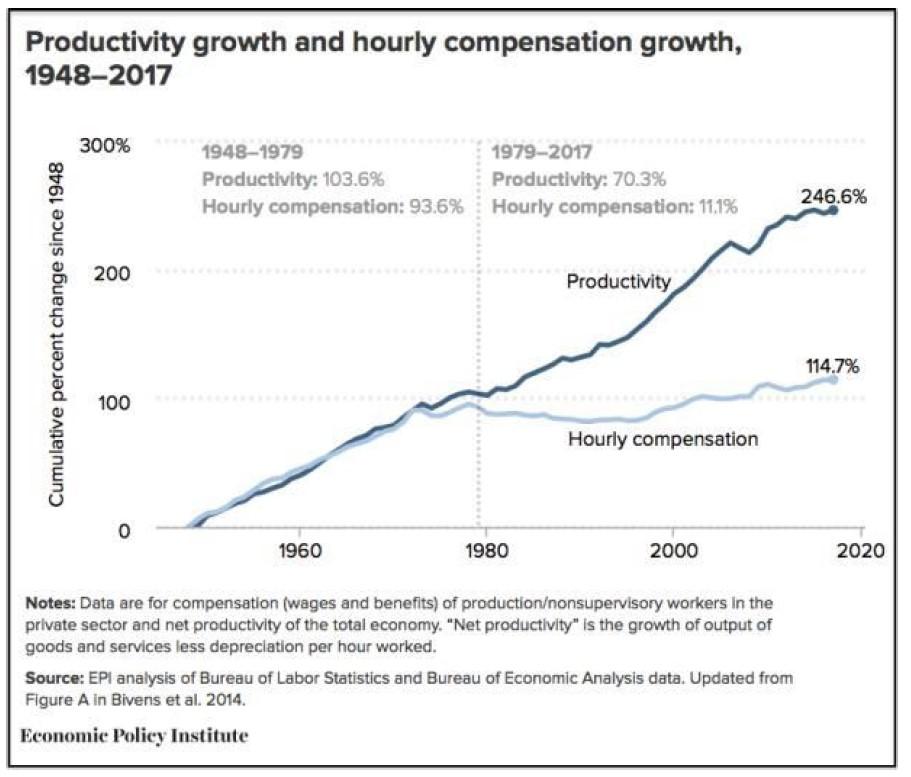
So, no, there is no necessary or automatic link between productivity and wages within the U.S. economy. There may have been such a relationship after World War II, during the socalled Golden Age of American capitalism, but not in recent decades.2
A natural question that arises is just where did the excess productivity – the extra surplus U.S. employers appropriated from their workers – go? A significant proportion, as I showed last year, went to higher corporate profits. Another large portion went to those at the very top of the wage distribution.
As is clear in Figure 6, the top 1 percent of earners saw cumulative gains in annual wages of 157.3 percent between 1979 and 2017 – far in excess of economy-wide productivity growth and nearly four times faster than average wage growth (40.1 percent). Over the same period, top 0.1 percent earnings grew 343.2 percent, with the latest spike reflecting the sharp increase in executive compensation.
In other words, corporate executives – on both Main Street and Wall Street – have been able to share in the extra booty captured from American workers, who were forced to have the freedom to sell their ability to work for wages that have barely increased in recent decades.
It’s clear then that, for decades now, American workers have been falling further and further behind. And there’s simply no justification for this sorry state of affairs – nothing that can rationalize or excuse the growing gap between the majority of people who work for a living and the tiny group at the top.
But that doesn’t stop mainstream economists from trying.
2 Even then, as I explained back in 2017: “The fact is, the supposed Golden Age of American capitalism was based on a set of institutions that allowed the boards of directors of large corporations to appropriate a growing surplus and to distribute it as they wished. At first, during the immediate postwar period, that meant growing incomes for those in the bottom 90 percent. But, even then, the mechanisms for distributing income remained in the hands of a very small group at the top. And they had both the interest and the means to stop the growth of wages, get even more surplus (from U.S. workers and, increasingly, workers around the globe), and distribute a greater share of that surplus to a tiny group at the very top of the distribution of income.”
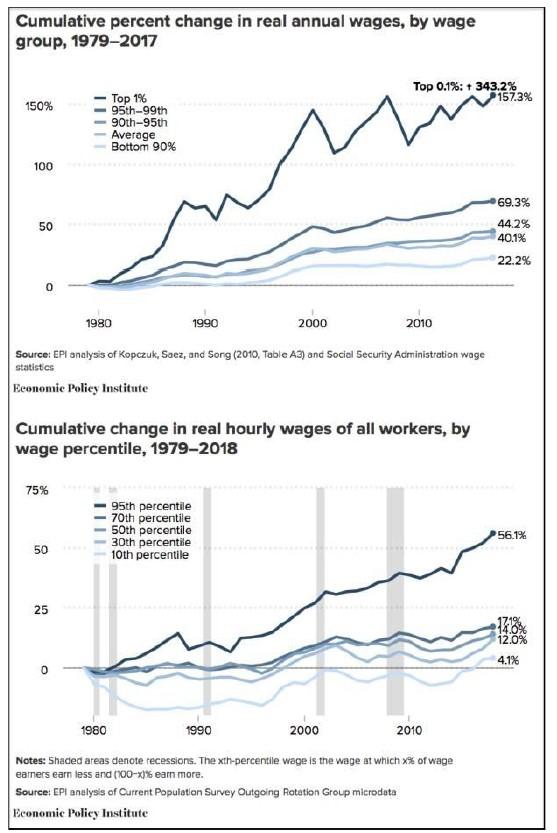
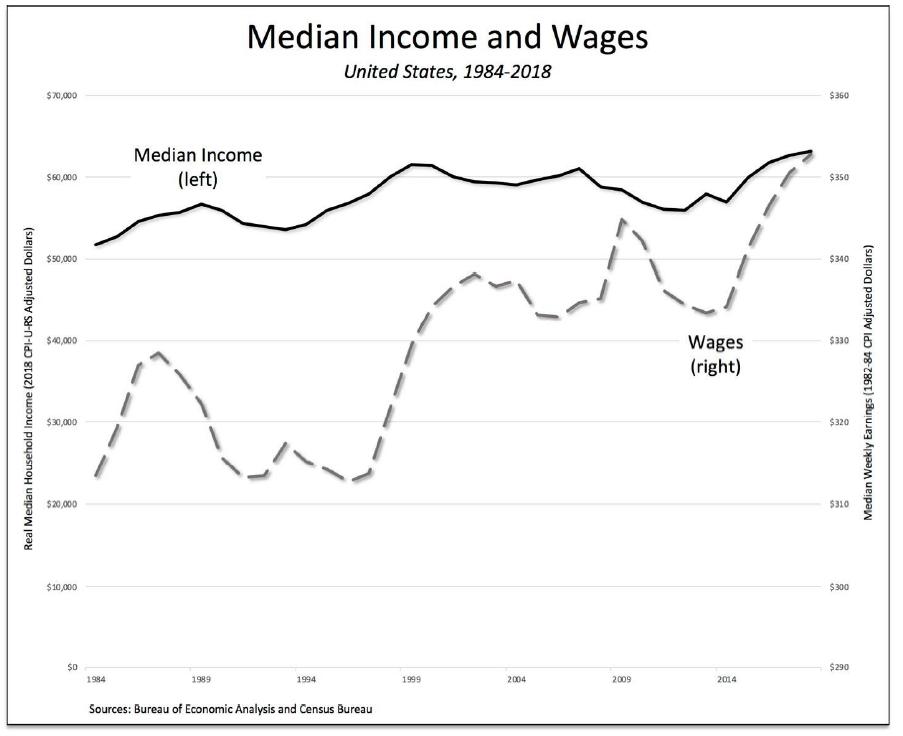
Look, they say, American workers are clearly better off than they were before. Both real median weekly earnings (the dashed line in Figure 7) and median real household income (the solid line) are higher than they were thirty years ago.
There’s no denying that, on average, the absolute levels of worker pay and household income have gone up. That’s proof, mainstream economists argue, that workers are enjoying the fruits of their labor.
The problem, though, is that, as I showed above (see Figure 5), the increase in workers’ wages pales in comparison to the rise in labor productivity.
In other words, American workers are producing more and more but getting only a tiny share of that increase.
It should come as no surprise, then, that the wage share of national income has fallen precipitously – by 8 percent since 1987 and by 16.5 percent since 1970.3
3 Let’s remember that the wage share is itself not an accurate representation of the share of income going to workers. That’s because, as I explained back in 2017, the wage share includes both the labor compensation of proprietors (and thus a portion, minus the capital share, of the income going to proprietors) as well as the multi-million-dollar salaries of corporate executives.
American workers are in fact experiencing a relative immiseration compared to their employers, who are able to capture the additional amount their workers are producing in the form of increased profits. Moreover, American employers have every interest – and more and more means at their disposal – to continue to widen the gap between themselves and their workers.
Not surprisingly, the relative immiseration of American workers shows up in growing inequality – with the share of income captured by the top 1 percent increasing and the share going to the bottom 90 percent falling (as shown in Figure 1 above). Each is a consequence of the other.
American workers are getting relatively less of what they produce, which means more is available to distribute to those at the top of the distribution of income.
That’s what mainstream economists can’t or won’t understand: that workers may be worse off even as their wages and incomes rise. That problem flies in the face of every attempt to celebrate the existing order by claiming “just deserts.”
There’s nothing just about the relative immiseration and growing inequality faced by American workers. And nothing that can’t be changed by imagining and creating a radically different set of economic institutions.
Surplus
Inequality in the United States is now so obscene that it’s impossible, even for mainstream economists, to avoid the issue of surplus.
Consider the two charts at the beginning of this essay. Income inequality is illustrated by the shares of pre-tax national income going to the top 1 percent (the red line) and the bottom 90 percent (the blue line). Between 1976 and 2016 (the last year for which data are available), the share of income at the top soared, from 10.9 percent to 19.3 percent, while for most everyone else the share has dropped precipitously, from 65.6 percent to 54.3 percent.
The distribution of wealth in the United States is even more unequal, as illustrated in Figure 2. From 1976 to 2016, the share of wealth owned by the top 1 percent (the green line) rose dramatically, from 21.9 percent to 36.6 percent, while that of the bottom 90 percent (the purple line) tumbled from an already-low 35.1 percent to an even lower 28.7 percent.
The obvious explanation, at least for some of us, is surplus-value. More surplus has been squeezed out of workers, which has been appropriated by their employers and then distributed to those at the top. They, in turn, have managed to use their ability to capture a share of the growing surplus to purchase more wealth, which has generated returns that lead to even more income and wealth – while the shares of income and wealth of those at the bottom have continued to decline.
But the idea of surplus-value is anathema to mainstream economists. They literally can’t see it, because they assume (at least within free markets) workers are paid according to their productivity. Mainstream economic theory excludes any distinction between labor and labor power. Therefore, in their view, the only thing that matters is the price of labor and, in their
models, workers are paid the full value of their labor. Mainstream economists assume we live in the land of freedom, equality, and just deserts. Thus, everyone gets what they deserve.
Even if mainstream economists can’t see surplus-value, they’re still haunted by the idea of surplus. Their cherished models of perfect competition simply can’t generate the grotesque levels of inequality in the distribution of income and wealth we are seeing in the United States. That’s why in recent years some of them have turned to the idea of rent-seeking behavior, which is associated with exceptions to perfect competition. They may not be able to conceptualize surplus-value but they can see – at least some of them – the existence of surplus income and wealth.
The latest is Mordecai Kurz, who has shown that modern information technology – the “source of most improvements in our living standards” – has also been the “cause of rising income and wealth inequality” since the 1970s.
For Kurz, it’s all about monopoly power. High-tech firms, characterized by highly concentrated ownership, have managed to use technical innovations and debt to erect barriers to entry and, once created, to restrain competition.
Figure 8
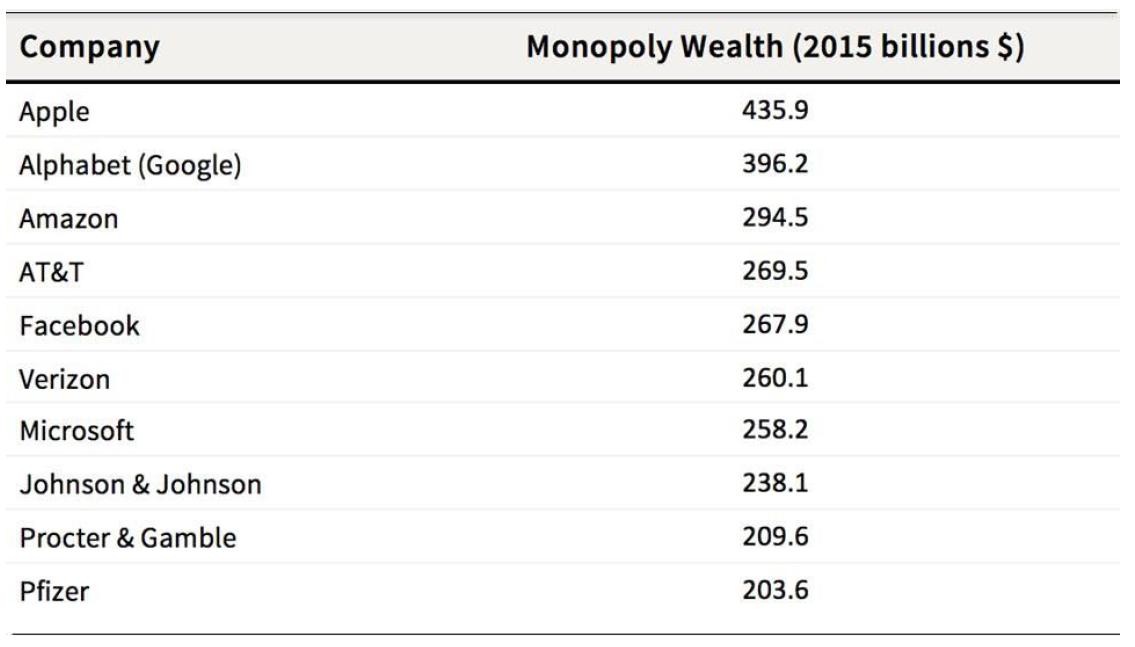
Thus, in his view, a small group of U.S. corporations has accumulated “surplus wealth” –defined as the difference between wealth created (measured as the market value of the firm’s ownership securities) and their capital (measured as the market value of assets employed by the firm in production) – totaling $24 trillion in 2015.
Here’s Kurz’s explanation:
One part of the answer is that rising monopoly power increased corporate profits and sharply boosted stock prices, which produced gains that were enjoyed by a small population of stockholders and corporate management. . .
Since the 1980s, IT innovations have largely been software-based, giving young innovators an advantage. Additionally, “proof of concept” studies are typically inexpensive for software innovations (except in pharmaceuticals); with modest capital, IT innovators can test ideas without surrendering a major share of their stock. As a result, successful IT innovations have concentrated wealth in fewer – and often younger – hands.
In the end, Kurz wants to tell a story about wealth accumulation based on the rapid rise of individual wealth enabled by information-based innovations (together with the rapid decline of wealth created in older industries such as railroads, automobiles, and steel), which differs from Thomas Piketty’s view of wealth accumulation (presented in his now-famous Capital in the Twenty-First Century) as taking place through a lengthy intergenerational process where the rate of return on family assets exceeds the growth rate of the economy.
The problem is, neither Kurz nor Piketty can tell a convincing story about where that surplus comes from in the first place, before it is captured by monopoly firms and transformed into the wealth of the tiny group of households at the top of the distribution.
Kurz and an increasing number of mainstream economists who have latched onto the rentseeking story (such as Joseph Stiglitz and Paul Krugman) are concerned about obscene and still-growing levels of inequality, and thus remained haunted by the idea of a surplus. But they can’t see – or choose not to see – the surplus-value that is created in the process of extracting labor from labor power.
In other words, mainstream economists won’t acknowledge the surplus that arises – in the dramatic language of the original critique of political economy – from capitalists’ “vampire thirst for the living blood of labor.”
Back to the future
The United States can’t stay this way forever – with physical distancing (even as some states have decided, precipitously, to allow many businesses to reopen), schools closed (and operating with a semblance of education through online teaching), and economic activity nosediving (even as the stock market soars).
The question that seems to be on everyone’s minds is, when are things going to go back to normal?
As I see it, the real question is, who wants to return to normalcy? The novel coronavirus pandemic has revealed, if nothing else, just how dysfunctional the situation was in the United States even before COVID-19 started to cut its deadly path from coast to coast. Tens of millions of workers have been furloughed or laid off and there’s still little relief for them in sight.
Instead, they’re being forced to have the freedom to drive to food banks to obtain groceries and other household supplies. All the while, their fellow employees, who labor in activities that have been deemed essential, are told to endure dangerous commutes on public transportation and to continue to work under perilous conditions, with little regard for their
economics review, issue no. 92 subscribe for free
personal safety. Workers didn’t have any say before in the decisions concerning their jobs, let alone in the other policies adopted by their corporate employers – and they certainly don’t now. 4
The pandemic has only served to demonstrate just how unequal life was in the United States before its arrival. According to the Federal Reserve’s Report on the Economic Well-Being of U.S. Households (updated to include some of the initial effects of the current crisis), many Americans came into the nationwide lockdown in a precarious financial situation, despite the so-called recovery from the Second Great Depression. At the end of 2019, three in ten adults said they could not cover three months’ worth of expenses with savings or borrowing in the case of a job loss, “indicating that they were not prepared for the current financial challenges.” Then things got worse: one in five people who were working in February reported that they lost a job or were furloughed in March or the beginning of April 2020, and the effects have been highly concentrated among low-wage workers. Fully 39 percent of former workers living in households earning $40 thousand or less a year lost their jobs, compared with 13 percent in those making more than $100 thousand.
A return to normalcy means going back to those same conditions – in which workers, blacks, Hispanics, and others who make up the bottom of the economic and social pyramid are assaulted by and fundamentally excluded from the major decisions that govern their economic and social lives.
Who would want to return to that?
Author contact: druccio@nd.edu
SUGGESTED CITATION:
Ruccio, David F. (2020) “The United States of inequality.” real-world economics review, issue no. 92, 29 June, pp. 33-47, http://www.paecon.net/PAEReview/issue92/Ruccio92.pdf
You may post and read comments on this paper at https://rwer.wordpress.com/comments-on-rwer-issue-no-92/
4 Unless, of course, they threaten to withhold their labor or go on strike, which more and more groups of American workers have begun to do, even as the unemployment numbers have soared.
